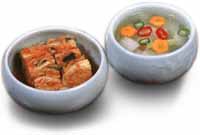
- Kimchi
In Korea, a king's
table may be set with delicacies from land and sea, but without a bowl of
kimchi, no Korean, king or commoner, will be satisfied. Despite the
Westernization of Korean society, where most men go to work in white dress
shirts and neckties, few adults can live without kimchi at every meal.
- Kimchi has a long history. In a poem, Yi Kyu-bo
(1168-1241), a distinguished man of letters during the Koryo Dynasty, wrote of
radishes pickled in salt for the winter months. Clearly, kimchi existed by the
latter part of the Koryo period. The spicy kimchi enjoyed today is believed to
have originated in the 1700s when red chili peppers were introduced to Korea.
Various regional varieties soon developed, including the white kimchi of
P'yong-an Province, which uses no red pepper powder, and the whole cabbage
kimchi flavored with bright red peppers and savory chotkal, fermented fish
paste, which is enjoyed in the southern provinces.
- Kimchi is a fermented food requiring
maturation. The unique tangy taste comes from fermentation at low
temperatures. In traditional society, large earthenware jars of kimchi were
buried in the ground, with only the tops exposed, during the winter months.
Fermentation was enhanced by the even temperature and heat emanating from the
ground. In this sense, kimchi represents the Korean philosophy that heaven,
earth and humanity are one.
Back to Main
Page Back to Korea Page

